
The Rhode Island Red is an American breed of domestic chicken. It is the state bird of Rhode Island. It was developed there and in Massachusetts in the late nineteenth century, by cross-breeding birds of Oriental origin such as the Malay with brown Leghorn birds from Italy. It was a dual-purpose breed, raised both for meat and for eggs; modern strains have been bred for their egg-laying abilities. The traditional non-industrial strains of the Rhode Island Red are listed as "watch" by The Livestock Conservancy.

The Plymouth Rock is an American breed of domestic chicken. It was first seen in Massachusetts in the nineteenth century, and for much of the early twentieth century was the most popular chicken breed in the United States. It is a dual-purpose breed, raised both for its meat and for its brown eggs. It is resistant to cold, easy to manage, and a good sitter.

The Dominique, also known as Dominicker or Pilgrim Fowl, is a breed of chicken originating in the United States during the colonial period. It is considered America's oldest breed of chicken, probably descending from chickens brought to New England from southern England during colonial times. By the 19th century, they were widely popular and were raised in many parts of the country. Dominiques are a dual purpose breed, being valued for their meat as well as for their brown eggs. They weigh 6 to 8 pounds at maturity. In earlier times, their feathers were much sought after as stuffing for pillows and mattresses.
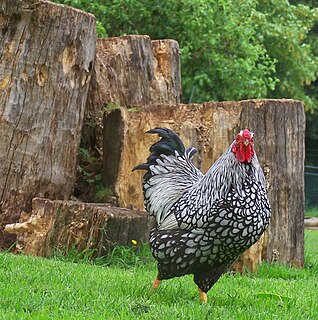
The Wyandotte is an American breed of chicken developed in the 1870s. It was named for the indigenous Wyandot people of North America. The Wyandotte is a dual-purpose breed, kept for its brown eggs and its yellow-skinned meat. It is a popular show bird, and has many color variants. It was originally known as the American Sebright.
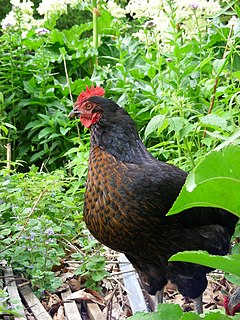
Sex-links are crossbred chickens whose color at hatching is differentiated by sex, thus making chick sexing an easier process. Sex-links come in several varieties. As hybrids of laying or dual-purpose breeds infused with extra vigor via heterosis, sex-links can be extremely good egg-layers which often produce 300 eggs a year or more depending on the quality of care and feed. The color of their eggs vary according to the mix of breeds, and blue-green eggs are possible.
The Legbar is a rare British autosexing chicken breed. It was created in the early twentieth century by Reginald Crundall Punnett and Michael Pease at the Genetical Institute of Cambridge University. It was created by cross-breeding Barred Plymouth Rock chicken, Leghorns, Cambars, and in the case of Cream Legbars, Araucanas. The Araucana blood in the Cream Legbar is reflected in its crest and blue to blue-green eggs.

The California Gray is an American breed of domestic chicken. It was developed in California in the 1930s by James Dryden, a professor of poultry science at Oregon Agricultural College, now Oregon State University. His aim was to produce a dual-purpose chicken that was both suitable for meat production and laid large white eggs. By crossing a Barred Plymouth Rock rooster and a White Leghorn hen, a naturally autosexing breed with gray barred plumage was produced. Largely because the breed was never recognized officially for exhibition by the American Poultry Association, California Grays are a rare breed in the 21st century. It is not listed on the conservation priority list of the Livestock Conservancy.

The Buckeye is a breed of chicken originating in the U.S. state of Ohio. Created in the late 19th century, Buckeyes are the only standard breed recognized by the American Poultry Association (APA) that is known to have been developed by a woman. It is the only breed in the American Class to have a pea comb. As of 2014, Buckeyes are listed as "Threatened" by The Livestock Conservancy. The breed's name is derived from Ohio's nickname of "Buckeye state". Their mahogany color is said ideally to resemble the seeds of the Ohio Buckeye plant. They are a dual-purpose chicken, known both for laying productivity and meat characteristics. Buckeyes are yellow-skinned chickens that lay brown eggs.
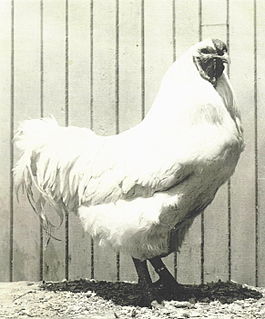
The Chantecler is a breed of chicken originating in Canada. The Chantecler was developed in the early 20th century, at the Abbey of Notre-Dame du Lac in Oka, Quebec. It is extremely cold-resistant, and is suitable for both egg and meat production.

The Rhode Island White is a breed of chicken originating in the U.S. state of Rhode Island. Despite their very similar names and shared place of origin, the Rhode Island White is a distinct breed from the Rhode Island Red. However, Rhode Island Reds and Whites can be bred together to create Red Sex Link hybrid chickens, such as the ISA Brown. In Australia, the Rhode Island White is regarded as a colour variety of the Rhode Island breed according to the Australian Poultry Standards.

The Delaware is a breed of chicken originating in the U.S. state of Delaware. It was once of relative importance to the U.S. chicken industry, but today is critically endangered. It is primarily suited to meat production but also lays reasonably well. It has plumage of a unique pattern, and is accepted into poultry standards for showing.

The Java is a breed of chicken originating in the United States. Despite the breed's name, a reference to the island of Java, it was developed in the U.S. from chickens of unknown Asian extraction. It is one of the oldest American chickens, forming the basis for many other breeds, but is critically endangered today. Javas are large birds with a sturdy appearance. They are hardy, and are well-suited for both meat and egg production, especially by small-scale farms, homesteads, and backyard keepers.
The Iowa Blue is a breed of chicken that originated near Decorah, Iowa in the early 20th century. Despite its name, the breed is not actually blue according to poultry standards. It is an exceedingly rare fowl, and is not recognized for showing by the American Poultry Association. They are a dual-purpose breed laying brown eggs and known to be good foragers.
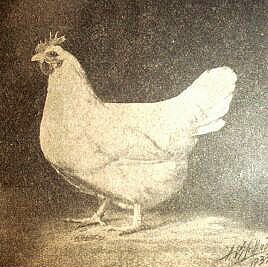
The Lamona is a breed of chicken originating in the United States. It was developed in the early 20th century by Harry S. Lamon, who was the senior poultry expert at the Bureau of Animal Industry, an agency that was eventually replaced by the U.S. Department of Agriculture's Agricultural Research Service.
The Potchefstroom Koekoek is a South African breed of chicken developed in the 1960s at the Potchefstroom Agricultural College in the city of Potchefstroom by Chris Marais. It was developed by cross breeding a number of other breeds like Black Australorp, White Leghorn, and Barred Plymouth Rock to obtain specific characteristics of each, making the resulting breed more suitable to Southern African conditions.
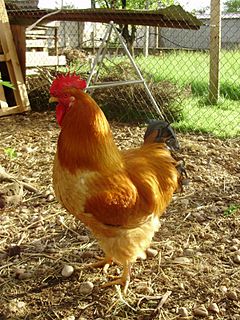
The Robusta Lionata is a recent dual-purpose breed of chicken originating in the city of Rovigo in the Veneto region of north-eastern Italy. It was created between 1959 and 1965, by cross-breeding Buff Orpingtons with the commercial strain known in Italy as "White America".

Solid black plumage color refers to a plumage pattern in chickens characterized by a uniform, black color across all feathers. There are chicken breeds where the typical plumage color is black, such as Australorp, Sumatra, White-Faced Black Spanish, Jersey Giant and others. And there are many other breeds having different color varieties, which also have an extended black variety, such as Leghorn, Minorca, Wyandotte, Orpington, Langshan and others.

In poultry standards, solid white is coloration of plumage in chickens characterized by a uniform pure white color across all feathers, which is not generally associated with depigmentation in any other part of the body.
All chicken breeds recognized by the American Poultry Association are categorized into classes. Standard-sized breeds are grouped by type or by place of origin; bantam breeds are classified according to type or physical characteristics.

















